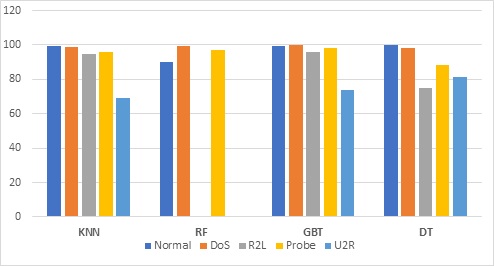Performance Evaluation of Classification Algorithms for Intrusion Detection on NSL-KDD Using Rapid Miner
DOI:
https://doi.org/10.33411/ijist/2022040110Keywords:
Intrusion Detection, Machine Learning, Rapid Miner, NSL-KDD, Intrusion Detection SystemAbstract
The rapid advancement of the internet and its exponentially increasing usage has also exposed it to several vulnerabilities. Consequently, it has become an extremely important that can prevent network security issues. One of the most commonly implemented solutions is Intrusion Detection System (IDS) that can detect unusual attacks and unauthorized access to a secured network. In the past, several machine learning algorithms have been evaluated on the KDD intrusion dataset. However, this paper focuses on the implementation of the four machine learning algorithms: KNN, Random Forest, gradient boosted tree and decision tree. The models are also implemented through the Auto Model feature to determine its convenience. The results show that Gradient Boosted trees have achieved the highest accuracy (99.42%) in comparison to random forest algorithm that achieved the lowest accuracy (93.63%).
References
H.-J. Liao, C.-H. R. Lin, Y.-C. Lin, and K.-Y. Tung, “Intrusion detection system: A comprehensive review,” J. Netw. Comput. Appl., 2013, vol. 36, no. 1, pp. 16–24.
T. T. Bhavani, M. K. Rao, and A. M. Reddy, “Network Intrusion Detection System Using Random Forest and Decision Tree Machine Learning Techniques,” in First International Conference on Sustainable Technologies for Computational Intelligence, Singapore, 2020, pp. 637–643. doi: 10.1007/978-981-15-0029-9_50.
P. Garcia-Teodoro, J. Diaz-Verdejo, G. Maciá-Fernández, and E. Vázquez, “Anomaly-based network intrusion detection: Techniques, systems and challenges,” Comput. Secur., 2009, vol. 28, no. 1–2, pp. 18–28.
C. Zhang, F. Ruan, L. Yin, X. Chen, L. Zhai, and F. Liu, “A deep learning approach for network intrusion detection based on NSL-KDD dataset,” in 2019 IEEE 13th International Conference on Anti-counterfeiting, Security, and Identification (ASID), 2019, pp. 41–45.
M. A. Salama, H. F. Eid, R. A. Ramadan, A. Darwish, and A. E. Hassanien, “Hybrid Intelligent Intrusion Detection Scheme,” in Soft Computing in Industrial Applications, Berlin, Heidelberg, 2011, pp. 293–303. doi: 10.1007/978-3-642-20505-7_26.
A. Sultana and M. A. Jabbar, “Intelligent network intrusion detection system using data mining techniques,” in 2016 2nd International Conference on Applied and Theoretical Computing and Communication Technology (iCATccT), 2016, pp. 329–333.
U. Fiore, F. Palmieri, A. Castiglione, and A. De Santis, “Network anomaly detection with the restricted Boltzmann machine,” Neurocomputing, vol. 122, pp. 13–23, 2013.
M. C. Belavagi and B. Muniyal, “Performance evaluation of supervised machine learning algorithms for intrusion detection,” Procedia Comput. Sci., vol. 89, pp. 117–123, 2016.
S. Thaseen and C. A. Kumar, “An analysis of supervised tree-based classifiers for intrusion detection system,” in 2013 International Conference on Pattern Recognition, Informatics and Mobile Engineering, 2013, pp. 294–299.
N. Shone, T. N. Ngoc, V. D. Phai, and Q. Shi, “A deep learning approach to network intrusion detection,” IEEE Trans. Emerg. Top. Comput. Intell., 2018, vol. 2, no. 1, pp. 41–50.
T. Ma, F. Wang, J. Cheng, Y. Yu, and X. Chen, “A hybrid spectral clustering and deep neural network ensemble algorithm for intrusion detection in sensor networks,” Sensors, 2016, vol. 16, no. 10, p. 1701.
S. Hosseini and S. R. Sardo, “Data mining tools -a case study for network intrusion detection,” Multimed. Tools Appl., 2021, vol. 80, no. 4, pp. 4999–5019, doi: 10.1007/s11042-020-09916-0.
J. Arunadevi, S. Ramya, and M. R. Raja, “A study of classification algorithms using Rapidminer,” Int. J. Pure Appl. Math., vol. 119, no. 12, pp. 15977–15988, 2018.
K. Siddique, Z. Akhtar, F. A. Khan, and Y. Kim, “KDD cup 99 data sets: A perspective on the role of data sets in network intrusion detection research,” Computer, 2019, vol. 52, no. 2, pp. 41–51.
R. Bala and R. Nagpal, “A review on kdd cup99 and nsl nsl-kdd dataset.,” Int. J. Adv. Res. Comput. Sci., 2019, vol. 10, no. 2.
S. Si, H. Zhang, S. S. Keerthi, D. Mahajan, I. S. Dhillon, and C.-J. Hsieh, “Gradient boosted decision trees for high dimensional sparse output,” in International Conference on Machine Learning, 2017, pp. 3182–3190.
T. Wan, H. U. Jun, P. W. Hui ZHANG, and H. E. Hua, “Kappa coefficient: a popular measure of rater agreement,” Shanghai Arch. Psychiatry, 2015, vol. 27, no. 1, p. 62.

Published
How to Cite
Issue
Section
License
Copyright (c) 2021 50Sea

This work is licensed under a Creative Commons Attribution 4.0 International License.




















